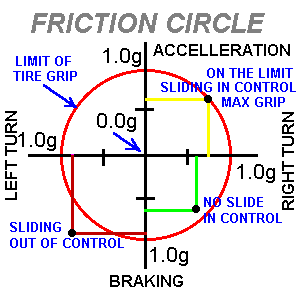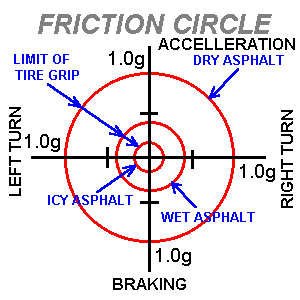THE FRICTION CIRCLE: THE SECRET OF VEHICLE CONTROL
by John Lee

When the flag drops, the bullshit stops. --Racing maxim
When a driver begins his journey, he carries with him the skills that will hopefully allow him to reach his destination intact. Yet enough passenger vehicle drivers are having a problem understanding the basic physics involved in the everyday use of their vehicles that many nasty accidents occur that need never have happened. Although the USA ranks almost dead last in the civilized world when it comes to comprehension of science, I shall attempt to explain a well-researched life-saving concept that the American government does not see fit to teach its students and drivers' license holders. Unlike the government, I suspect that American drivers enjoy learning about how to become better drivers, and that they are actually intelligent enough to do so. Although it may be considered heretical to say so, driving can actually become fun when a driver no longer fears the hidden quirks of his vehicle. The more control he has, the less likely he is to crash, and the more likely he is to pay attention. Every racing driver of any competence must learn this simple fact of life, and any highway driver who wishes to become a safer driver must also acknowledge this fundamental reality. Although the mathematics involve geometry and trigonometry, a citizen does not need these skills in order to grasp the initial concept.
All vehicles respond to knowledge of a tire's friction circle. |
Racing drivers are intimately aware that tires can only produce a certain amount of traction (cornering force, grip, whatever you want to call it), measured in G-force of acceleration. One "G" is equal to the amount of force of gravity, measured in a sideways instead of vertical direction. "Acceleration," in the engineering sense, is defined as a change in "velocity." Velocity is composed of both speed and direction. So acceleration means changing speed or changing direction, or both. This acceleration applies not only when a vehicle is accelerating forward in the traditional sense, but also applies when a vehicle is accelerating sideways (cornering at a steady speed), or accelerating rearward (slowing down by braking). Assume a hypothetical tire can produce a maximum of only 1.0G of acceleration. If a driver needs to speed up while also going around a corner, his tires are still limited to 1.0G total. For the sake of trivia, a racing "slick" can produce up to 1.5G, and up to 5.0G when aerodynamic downforce is added.
It is a popular misconception, encouraged by the government, that once a vehicle begins to slide, it is out of control. Nothing could be further from the truth. Accident reports by police always diagram the "skid marks," with careful measurements of their distance (but are inadmissible as evidence in a court of law). Racing cars always leave skid marks on every single corner they navigate, perhaps 800 times in a single race -- it is the only way to achieve maximum adhesion. Many accidents needlessly occur because a citizen panicked at the first hint of tire slippage. Maximum traction actually occurs with a slight amount of tire slippage against the rough asphalt surface. Maximum braking occurs at 10 to 15% slippage, and maximum cornering occurs at 5 to 10% slippage, as proven by numerous engineering studies and daily racing team computer datalogging records. This maximum grip occurs because the rubber in the tire is being torn away by the extreme forces involved, although the tire must be rotating to achieve this grip. By explaining this phenomenum, the author certainly not advocating that highway drivers try this out for themselves -- only on race tracks can this be done safely and affordably, since "controlled" crashes are usually involved in the learning process. However, like a pilot that must learn how to recover from an "out of control" spin before the government grants him a license to fly, a typical citizen can also benefit from knowledge of how to handle a rare emergency procedure.
That means, for example, 0.5G is available for speeding up, and 0.5G is available for cornering, for a combined total of 0.7G. It does not mean the tires can produce 1.0G plus an additional 1.0G for a total of 2.0G. Of course, this also holds true for braking while going around a corner. The tires can only handle perhaps half of their normal cornering ability. This is a very basic explanation of how this phenomenon works; to drive at the extreme limit of a vehicle's performance, such as in racing, a driver needs to be aware of a great many other factors, and requires years of experience (which includes lots of crashes in a controled environment), and also an excellent understanding of vehicle engineering dynamics.
These G-forces only apply to dry, paved roads, with gravity pulling the vehicle weight downward at a continous rate. When a driver goes over the crest of a hill or drives over a bump or dip in the road surface, the pull of gravity suddenly is reduced. The amount of this sudden reduction depends on how big the crest of bump is. For instance, a driver can suddenly find himself out side of the friction circle, with a total loss of control. If the road does not stabilize quickly enough, a driver can find himself in a crash.
Tire grip changes up to 90% depending on highway conditions. | On wet roads, traction can be reduced to only 30% compared to dry traction. This is because the water lubricates the asphalt, filling in the microscopic pores that normally give the tire's rubber something to hold on to. This changes the friction circle significantly. There is also a complete loss of the tire's ability to benefit from slippage. No slippage is tolerated on a wet road. Suddenly hitting a wet patch on a curve, such as commonly occurs when random shade trees slow down evaporation after a rainstorm, can catch a driver off-guard, resulting in a loss of control. Ice can instantly drop grip to 10% of dry traction. Use of metal-studded snow tires or tire chains reverse this loss of grip. Motorcycles that use studded tires for racing actully have MORE grip that a rubber tire on dry asphalt, and can scrap their handlebars while leaning into curves. Without chains or studs, not even 4-wheel-drive vehicles can escape the 90% loss of traction, as witnessed by their crashes at the bottom of icy hills.
Unfortunately, any loss of cornering traction due to braking occurs when the front tires are also needed for steering. A great many crashes occur because of this loss of steering control, when least expected, at the most dangerous time, to a driver who has never been told to expect this, nor trained in how to correct for it. This loss of control can even occur in even a very low speed situation. The government has determined that most crashes occur below 40 MPH.
Modern anti-lock brake (ABS) computers, even when they use anti-yaw technology, still do not increase throttle power when it is critical to do so (anti-spin "traction control" technology reduces throttle power). Anti-lock brakes do not work well in a corner -- once a car is sliding sideways, ABS is ineffective for regaining control. This is one reason race cars do not use ABS. ABS is very good for many situations, such as changing front and rear braking ratio for changing weather conditions (90% of braking is performed by front wheels in dry conditions, but only 50% in wet conditions). ABS does not help with throttle-off understeer.
Imagine if the government stopped training aircraft and airline pilots in methods of maintaining control in emergency situations? No one would ever fly in an airliner, and perhaps few would survive flying in a smaller aircraft. Yet this is not dissimilar from the condition of driving on the highways of America today. Even if we ourselves never face a difficult driving situation that results in a loss of control, we must still contend with millions of fellow drivers who might lose control and be clueless in methods of how to regain control before crashing into us. Wouldn't it be great if every driver were trained in how to regain control in emergency situations?
|























